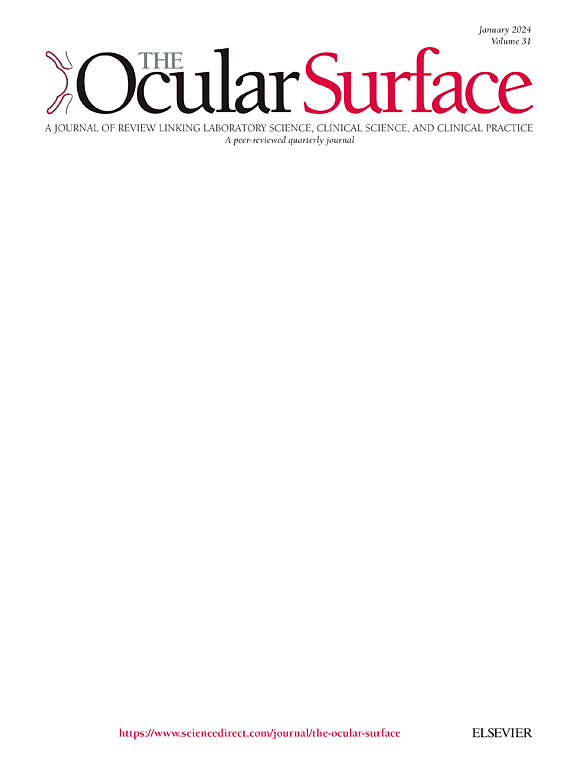眼烧伤中的单纯角膜缘上皮移植与角膜缘上皮培养移植。
IF 5.9
1区 医学
Q1 OPHTHALMOLOGY
引用次数: 0
摘要
目的:比较单纯瓣上皮移植术(SLET)和培养瓣上皮移植术(CLET)治疗单侧眼烧伤后全瓣干细胞缺乏症(LSCD)的疗效:随机对照试验。方法:100 名眼部烧伤后单侧全缘干细胞缺乏症患者(100 只眼)接受自体眼缘干细胞移植术(LSCT),并随机分为 SLET 组和 CLET 组。恢复上皮化的眼表是衡量疗效的主要指标。术后出现进行性结膜化和持续性上皮缺损被视为手术失败:平均年龄为 20.2 ± 13.1 岁(SLET)和 22.6 ± 14.3 岁(CLET)(p = 0.363)。碱烧伤是两组患者最常见的致病因素,两组患者发病时的 BCVA 平均对数值相当[SLET:2.33 ± 0.5,CLET:2.23 ± 1.48 (p = 0.652)]。从受伤到手术干预的中位时间间隔为 18 个月(SLET)和 12 个月(CLET)(p = 0.06)。SLET组88%的眼睛在1年后眼表保持稳定,而CLET组为86%(p = 0.999)。两组患者的 BCVA 平均对数均有显著改善,SLET 组在 6 个月(p = 0.0390)、1 年(p = 0.0001)、2 年(p = 0.0001)和 3 年(p = 0.0001)随访期间的 BCVA 均明显优于 CLET 组。Kaplan-Meier生存率分析结果显示,两组间差异无统计学意义(p = 0.590):结论:与 CLET 相比,SLET 在恢复和维持因眼部烧伤导致的全 LSCD 眼的眼表稳定方面同样有效,而且还具有视觉效果更佳的优势。本文章由计算机程序翻译,如有差异,请以英文原文为准。
Simple limbal epithelial transplantation versus cultivated limbal epithelial transplantation in ocular burns
Purpose
To compare the outcomes of simple limbal epithelial transplantation (SLET) with cultivated limbal epithelial transplantation (CLET) for the management of total limbal stem cell deficiency (LSCD) in eyes with unilateral ocular burns.
Design
Randomized controlled trial.
Methods
100 patients (100 eyes) with unilateral total LSCD following ocular burns undergoing autologous Limbal Stem Cell Transplantation (LSCT) were enrolled and randomized into SLET and CLET groups. Restoration of an epithelized ocular surface was the primary outcome measure. Occurrences of progressive conjunctivalization and persistent epithelial defects postoperatively were considered surgical failures.
Results
Mean age was 20.2 ± 13.1 years (SLET) and 22.6 ± 14.3 years (CLET) (p = 0.363). Alkali burn was the most common causative factor in both groups and had comparable mean logMAR BCVA at presentation [SLET: 2.33 ± 0.5, CLET: 2.23 ± 1.48 (p = 0.652)]. Median time interval between injury and surgical intervention was 18 months (SLET) and 12 months (CLET) (p = 0.06). 88 % eyes in SLET group maintained a stable ocular surface at 1 year period versus CLET group (86 %) (p = 0.999). Mean logMAR BCVA significantly improved in both groups with SLET having significantly better BCVA versus CLET at 6 months (p = 0.0390), 1 year (p = 0.0001), 2 year (p = 0.0001) and 3 years (p = 0.0001) follow up. Kaplan-Meier survival analysis was statistically insignificant amongst the 2 groups (p = 0.590).
Conclusions
Compared to CLET, SLET is equally efficacious in restoring and maintaining a stable ocular surface in eyes with total LSCD due to ocular burns, with the added advantage of providing superior visual outcomes.
求助全文
通过发布文献求助,成功后即可免费获取论文全文。
去求助
来源期刊

Ocular Surface
医学-眼科学
CiteScore
11.60
自引率
14.10%
发文量
97
审稿时长
39 days
期刊介绍:
The Ocular Surface, a quarterly, a peer-reviewed journal, is an authoritative resource that integrates and interprets major findings in diverse fields related to the ocular surface, including ophthalmology, optometry, genetics, molecular biology, pharmacology, immunology, infectious disease, and epidemiology. Its critical review articles cover the most current knowledge on medical and surgical management of ocular surface pathology, new understandings of ocular surface physiology, the meaning of recent discoveries on how the ocular surface responds to injury and disease, and updates on drug and device development. The journal also publishes select original research reports and articles describing cutting-edge techniques and technology in the field.
Benefits to authors
We also provide many author benefits, such as free PDFs, a liberal copyright policy, special discounts on Elsevier publications and much more. Please click here for more information on our author services.
Please see our Guide for Authors for information on article submission. If you require any further information or help, please visit our Support Center
 求助内容:
求助内容: 应助结果提醒方式:
应助结果提醒方式:


